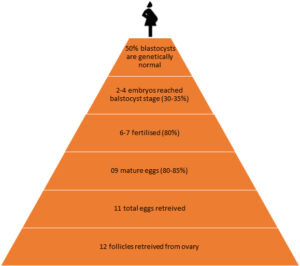Understanding IVF Attrition Rates

Many women wonder that why the total number of blastocysts formed in IVF cycle are less than the number of eggs retreived per IVF cycle!!!
IVF Attrition Pyramid

Is it something wrong with my eggs and their quality??
– The answer is absolutely no. 😊
– This is called the IVF Attrition rate. This is complete natural occurance and happens to every woman.
Attrition rates remain fairly steady, but can vary based on several factors, including:
- Woman age: Young women tend to have higher rates of blastocyst formation. Age 35 is the typical end point quality begins to decline.
- Egg quality: High-quality eggs result into higher number of blastocysts.
- Embryo quality: Embryos with normal chromosome numbers have a higher chance of reaching till Day 5 development stage (blastocyst).
- Specific month IVF cycle: Blastocyst formation rates can vary from month to
The greatest IVF attition rate is observed from day 3 embryo to reaching day 5-6 embryos. Only 30-50% of day 3 embryos can make up to blastocyst stage.
So What could be the actual percentage of success in IVF cycle? The general success rate can be broken down into commonly seen percentages:
✅ mature eggs should be at least 80% of all eggs retreived
✅ fertilization rate should be 80% of all injected oocytes
✅ 30-50% of ferrtilized embryos should reach till blastocyst stage.
Can IVF Attrition be Avoided?
Since IVF attrition is a natural selection of decrease in the number of viable embryos during the IVF process, it cannot be completely prevented. However, there are measures that can be taken to minimize it and increase the chances of successful embryo development:
- Comprehensive fertility check up: A thorough evaluation of both partners’ current fertility status can help to identify any underlying problems that might contribute to higher rates of attrition. It includes diagnostic tests to assess ovarian reserve, sperm quality, sperm DNA fragmentation level, hormone levels, and genetic markers.
- Personalized treatment: Same treatment can’t fit for all. Tailoring IVF protocols to each patient’s specific requirement can optimize ovarian stimulation and numbers of egg retrieved, potentially improving the embryo numbers and embryo
- Advanced laboratory techniques: Utilizing modern techniques such as intracytoplasmic sperm injection (ICSI), microfluidic slides to select the sperms with least DNA fragmentation, assisted laser hatching, PGT-A, PGT-Mcan help to identify and select the healthiest embryos for transfer, potentially reducing the rate of attrition.
- Optimal embryo culture environment: Ensuring the best possible culture conditions for embryo development in the laboratory, including temperature, pH, CO2 level, nutrient levels, changing culture media at regular interval and using specific substances such as calcium ionophorescan enhance embryo survival and growth.
The Bottom Line: Attrition is absolutely Normal
While IVF attrition may be a difficult concept to accept and to digest for the fertility specialist and couples, the most important aspect to know is that this process is natural and routine, regardless of your cause of infertility and disease.
Keep in mind: Even single embryo/ blastocyst at the end of an IVF cycle treatment offers you an excellent chance of a healthy pregnancy, and the earlier you begin your fertility treatment journey, the better are your chances of getting more high-quality embryos.
If you’re struggling to be pregnant and want to explore potential ways to parenthood, Dr. Ripal Madnani and team at Health plus Fertility clinic, Abu Dhabi is ready to help make your dreams come true. When you’re ready physically, and emotionally to take the next step, reach out to me to get started.
